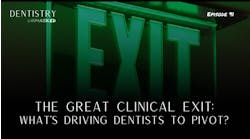As a dental practice owner, you likely have one overriding financial goal: maximizing your profits. However, making the most of your business value should not be discounted.
We’ll look at two methods that can help you measure profitability in different ways, so you can focus on making your practice the best it can be. Read part one of our series, Dental practice accounting: Why financial statements are key to growing your practice and your wealth.
Fundamentally, measuring profits is indispensable in determining the value of a business, so what’s the best way to measure profitability? We’ve looked closely at dental practice financial statements in this series. The income statement shows you the top line (your revenue) and the bottom line (your net profit). While this may show how much the business earned, many variables can impact these numbers.
Some essential elements rest in between. Though these elements are not officially recognized under generally accepted accounting principles (GAAP) or included in GAAP-compliant financial statements, they are tremendously important measures in the economic life of your business.
Two specific formulas commonly used for that purpose are known by their acronyms: EBIT and EBITDA. These metrics can help you analyze profits without interfering with variables so you can more accurately measure your actual progress.
Why not net income?
Why is net income not a clear measurement of a company’s performance? The bottom line (net income) is burdened by post-earnings values—i.e., capital structures and tax obligations. Additionally, net income includes unnecessary items that influence the practice’s profitability, such as depreciation. In contrast, EBIT and EBITDA exclude these pieces of information, allowing investors and analysts to use the values for investment analysis or business valuations. Consequently, these two metrics are more functional measures of financial performance.
What is EBIT?
EBIT stands for earnings before interest and taxes: EBIT = net income + interests + taxes.1 Each of these values can be found on the income statement.
EBIT is a company’s net income before income taxes. The number is used to analyze the performance of the core operations of a business without tax expenses or the costs of the capital structure influencing profit.1 As the formula suggests, the EBIT value is higher than net income.
What is EBITDA?
This mouthful of an acronym is similar to EBIT. EBITDA stands for earnings before interest, taxes, depreciation, and amortization: EBITDA = net income + interest + taxes + depreciations + amortizations.2
EBITDA is another widely used indicator to measure financial performance and project earnings potential. It reflects the profitability of a business’s operational performance before deductions for capital assets, interest, and taxes.1
EBITDA is more complicated, because, in addition to excluding cash expenses such as interest and taxes, it adds back in two other noncash expenses: depreciation and amortization. Depreciation and amortization can be recorded in several areas of the income statement, and you’ll also find them detailed in the cash flow statement. By default, EBITDA is higher than both net income and EBIT. The higher the number, the better your profitability for the period.
Restrictions on EBIT and EBITDA
EBIT and EBITDA are not officially recognized metrics under GAAP, a set of guidelines maintained by the Financial Accounting Standards Board (FASB). To satisfy statutory reporting requirements, public companies and other financial institutions that must comply with GAAP principles cannot use EBIT or EBITDA as a substitute for GAAP-approved metrics.
Many financial companies, specifically valuation firms, still choose to report EBIT and EBITDA in addition to the GAAP-approved metrics, because they are instrumental in analyzing performance and valuation. Private practice owners, valuators, and investors find these metrics helpful. EBITDA is commonly used in the valuation process for dental practices.
Components of EBIT and EBITDA
To properly use EBIT and EBITDA, one needs to understand each element of the formula:
- Earnings: Earnings are what your company brings in over a certain period. To determine this EBITDA component, subtract operating expenses from total revenue.
- Interest: An interest expense refers to the cost of servicing debt. It can also represent interest earned, though it generally refers to an expense. In EBITDA, the costs associated with interest are not deducted from earnings.
- Taxes: Only two things are certain in life—death and taxes—except for EBITDA, which measures business earnings before taxes are paid. Earnings before interest and taxes is also commonly referred to as operating profit, which can be expressed as EBIT.
- Depreciation and amortization: Depreciation represents the loss in value of tangible assets generally related to use over time, such as machinery or vehicles. An amortization expense is related to the eventual expiration of intangible assets, such as patents. In EBITDA, depreciation and amortization are added back into operating profit.3
You may be wondering just how important these metrics are. Joseph Feriollo, a director of Wise Business Plans, stated: “EBITDA is one of the—if not the most—important measures that investors consider when a company is being bought or sold. If I was going to invest, my primary concern would be ensuring that the business had an audited, up-to-date EBITDA analysis.”3
EBIT vs. EBITDA
Both EBIT and EBITDA are measures of a business’s profitability. Both acronyms may be the most popular financial metrics used to evaluate fiscal performance. However, EBIT and EBITDA are two different forms of the measurement of net income.
EBIT stands for earnings before interest and taxes. EBITDA stands for earnings before interest, taxes, depreciation, and amortization. The key term in these concepts is the word before. It means both measures show how much money the business made before other nonbusiness-related costs are paid. They measure a business’s ability to generate cash.
EBIT is a measure of operating profit—net income before interest and taxes (cash expenses) are deducted. EBITDA, additionally, excludes depreciation and amortization (which are not cash expenses) from the other costs, increasing the final financial outcome.
More about dental accounting ... Why financial statements are the key to growing your practice and your wealth
EBIT is also called operating income. EBITDA is income after subtracting the costs of goods sold and operating expenses. EBITDA is always greater than EBIT, because it excludes more expenses from the earnings. EBITDA has traditionally been used more often than EBIT in financial analysis and business valuations and is considered a vital financial metric.
Where do we use EBITDA?
EBITDA is useful in the following business activities:
- Budgeting: to determine the practice’s ability to generate revenue and potentially meet new financial obligations.
- Investing: to decide if you have enough capital and financial abilities to invest in acquisition or expansion.
- Planning an exit strategy: to plan the sale of your practice. EBITDA is one of the most important metrics used for financial analysis and valuation, and it can prove to buyers that the actual value of your practice is reflected in the correct asking price.
- Business restructuring or downsizing: EBITDA analysis will help you to make objective—not subjective—upsizing or downsizing decisions based on actual financial metrics.
Why these metrics matter
Why do dental practices even need these measures? After all, the bottom line of any income statement displays net earnings, so why look further? Taxes and interest may not be something you can control, but you can’t necessarily avoid them either.
These metrics are used extensively by those looking to buy or invest in dental practices. With these statistics, potential buyers can more easily compare different practices. If you’re interested in eventually selling your practice, you’ll want to evaluate your EBIT and EBITDA frequently.
And yes, taxes and interest do matter. Taxes, deductions, and the cost of capital play an essential role in the financial dynamics of business operations. Moreover, the critical point is that because both EBIT and EBITDA ignore the cost of servicing debt, they can sometimes provide a misleading picture of a business.⁴
While potential buyers look closely at EBIT and EBITDA, these are not the only metrics that should be examined. Potential investors can get a fuller picture of overall business operations and performance by reviewing all elements of financial dynamics.
Seeing the practice through an outsider’s eyes
Investors, buyers, and value analysts rely heavily on EBIT and EBITDA to compare apples to apples when assessing dental practices. While practices may have different capital structures and be located in areas where taxation structures differ, applying EBITDA values allows for the normalizing of value metrics. By removing variables related to taxation and cost of capital in particular, potential buyers can get a clearer view of the underlying operation’s performance and potential for cash flow generation.
EBITDA can be used to remove critical factors that may cloud the view of how well a dental practice is operating:
- Taxes, since these can fluctuate and are often not in your control.
- Interest may not concern a practice buyer since they may plan to access cheaper capital (personal financing) or eliminate debt altogether.
- Depreciation and amortization are both added back in since they are noncash expenses.
Boosting metrics to increase practice value
EBITDA is an essential metric in practice valuation. Dental practices are commonly valued at anywhere from four to 15 times EBITDA, depending on many other factors. To make your practice appear more attractive, you may want to increase and stabilize EBITDA. The EBITDA used for valuations should not be a single number. EBITDA is typically averaged over the previous three to five years to validate the accuracy of calculations.
How to improve EBITDA
One way is to decrease your expenses. The lower your costs, the higher your EBITDA. Every dollar you save could parlay into a much more significant change in potential sales price for the practice.
The second way is to increase the top line by growing revenues, which will boost your EBITDA and subsequently your sales price.
EBIT and EBITDA are incredibly useful financial control metrics. They give practice owners and potential buyers insight into the health of the business as well as assist in determining practice value. The more you learn about these metrics and other financial principles, the more knowledge you’ll have to leverage your dental practice into an even more substantial retirement asset.
Author’s note: The authors have no financial interest in any companies mentioned in this article.
Editor's note: This article appeared in the September 2023 print edition of Dental Economics magazine. Dentists in North America are eligible for a complimentary print subscription. Sign up here.
References
- Murphy CB. EBIT vs. EBITDA: what’s the difference? Investopedia. Updated May 12, 2022. https://www.investopedia.com/ask/answers/020215/what-difference-between-ebit-and-ebitda.asp
- Johnson S. What Is EBITDA? Business News Daily. Updated February 28, 2023. https://www.businessnewsdaily.com/4461-ebitda-formula-definition.html
- EBITDA. Business Development Bank of Canada. 2022. https://www.bdc.ca/en/articles-tools/entrepreneur-toolkit/templates-business-guides/glossary/ebitda
- Silva D. What is EBITDA and how is it calculated? Yahoo finance. February 28, 2019. https://finance.yahoo.com/news/ebitda-calculated-210414892.html









